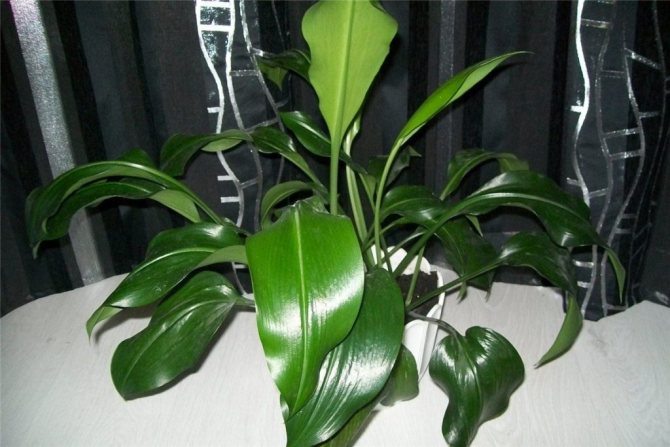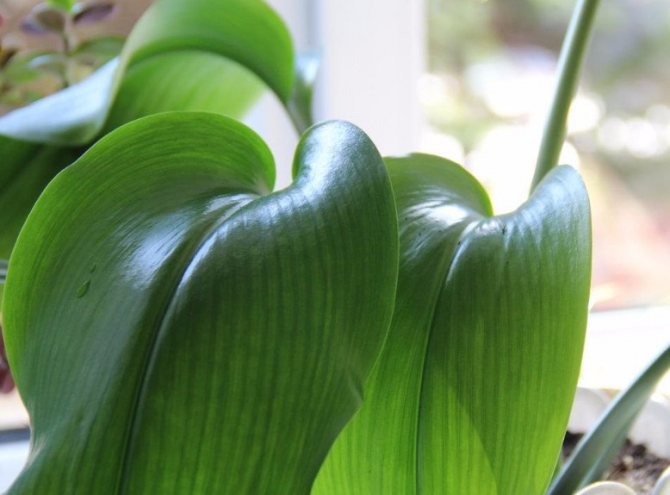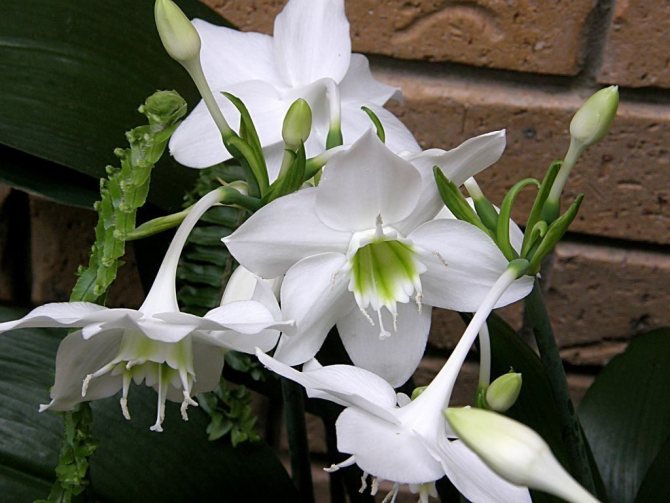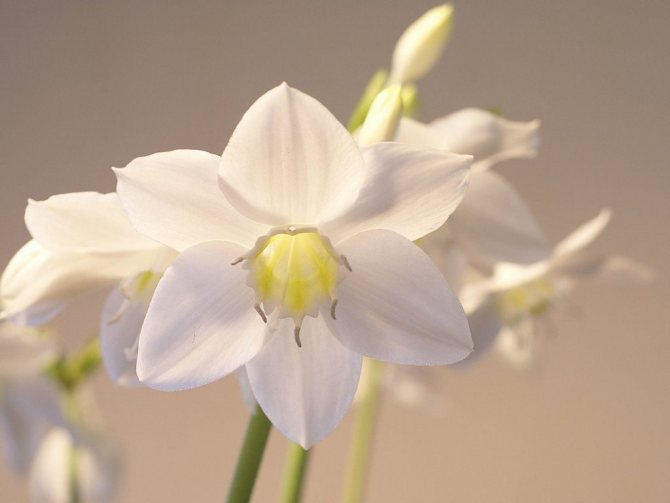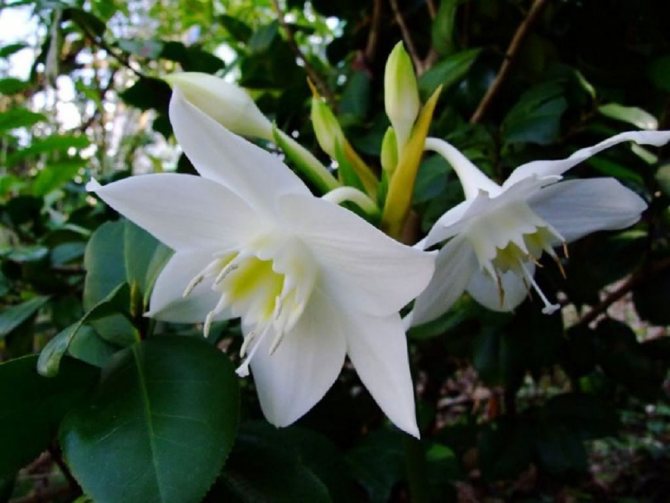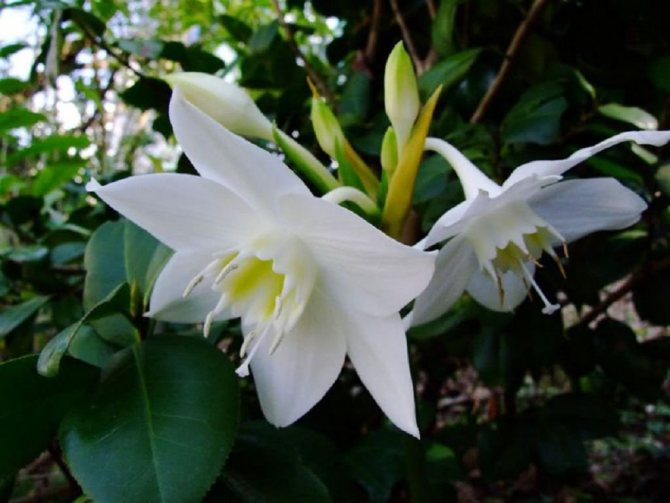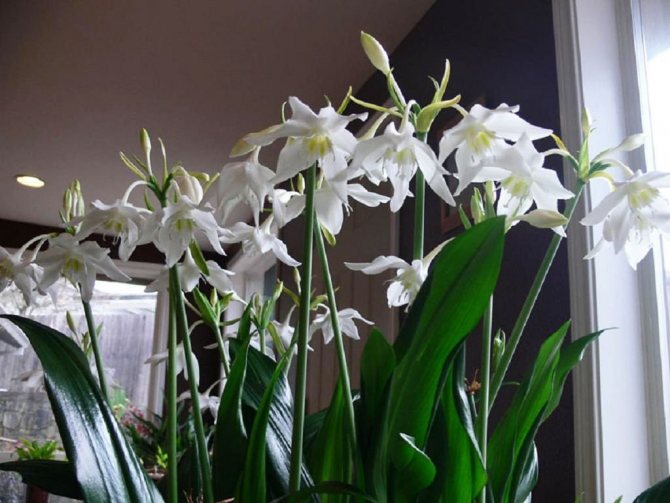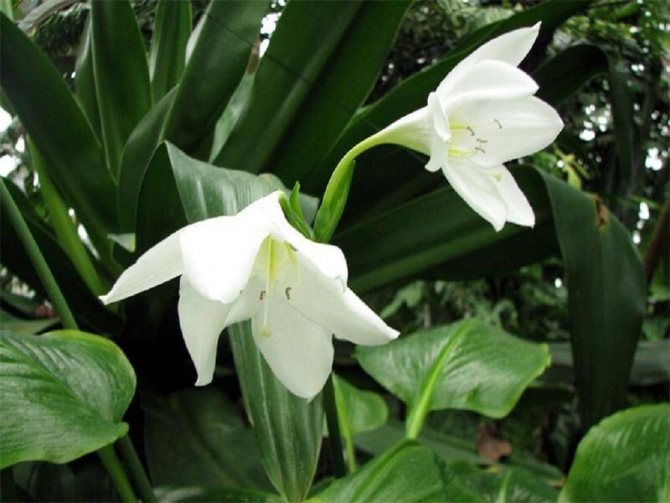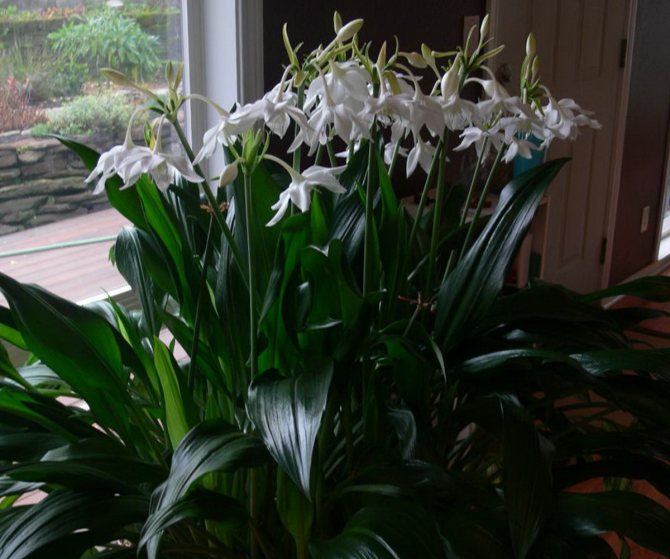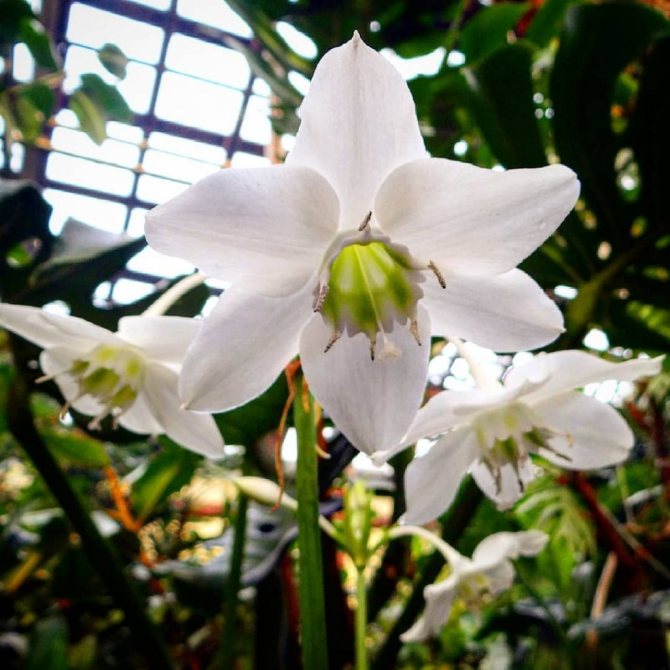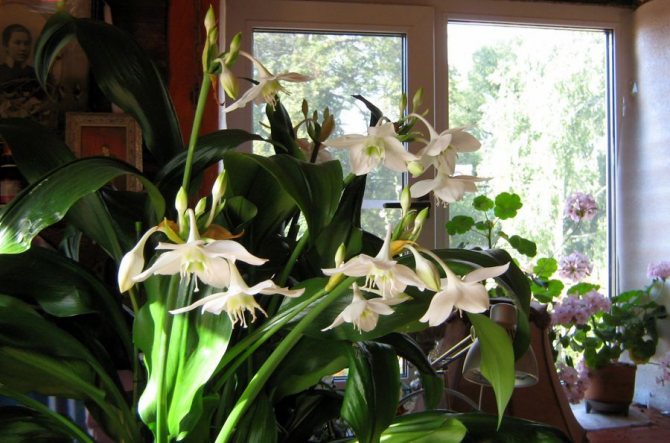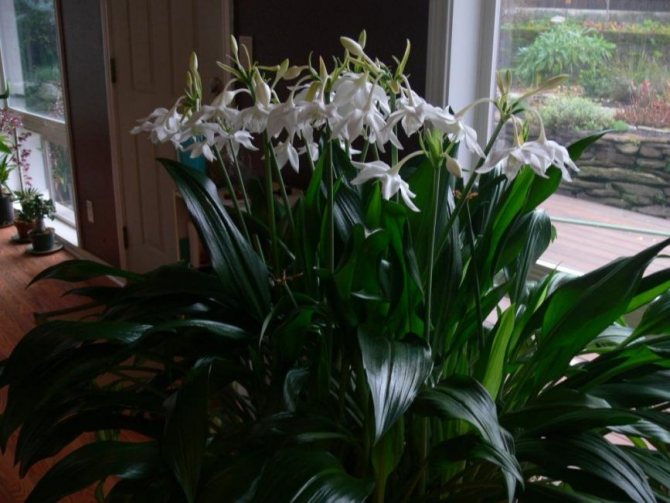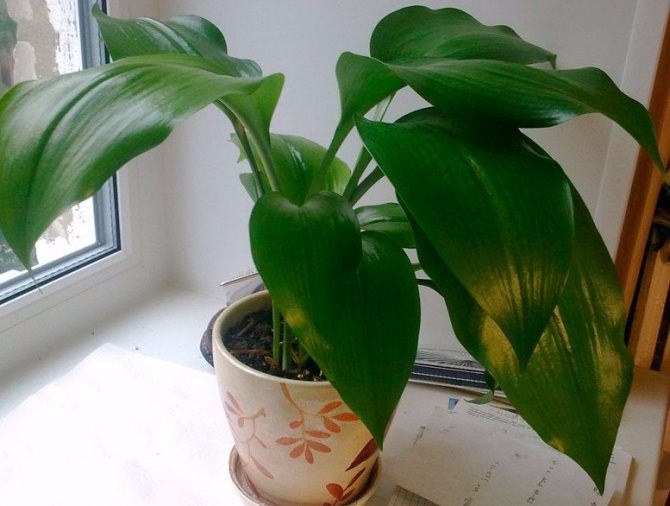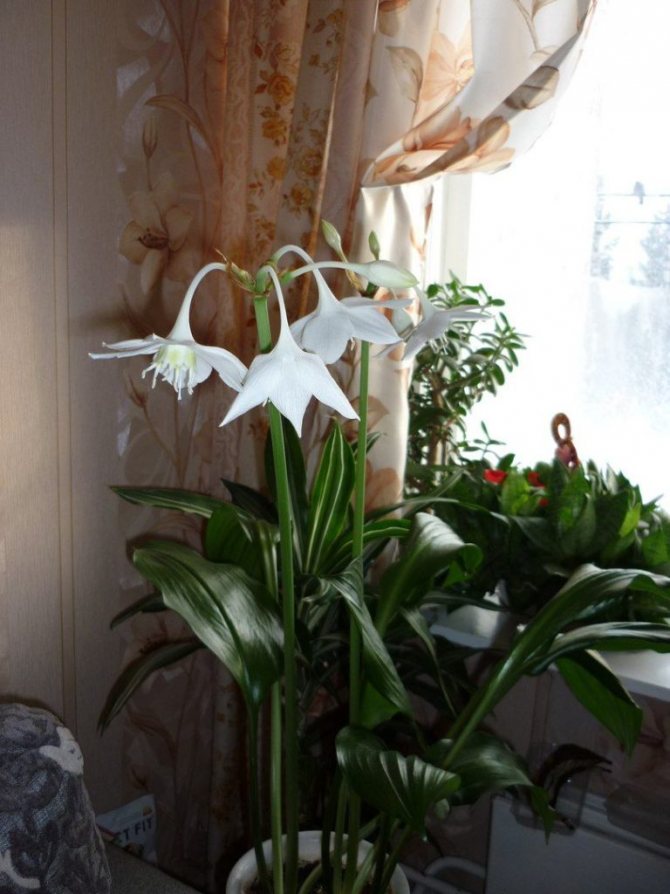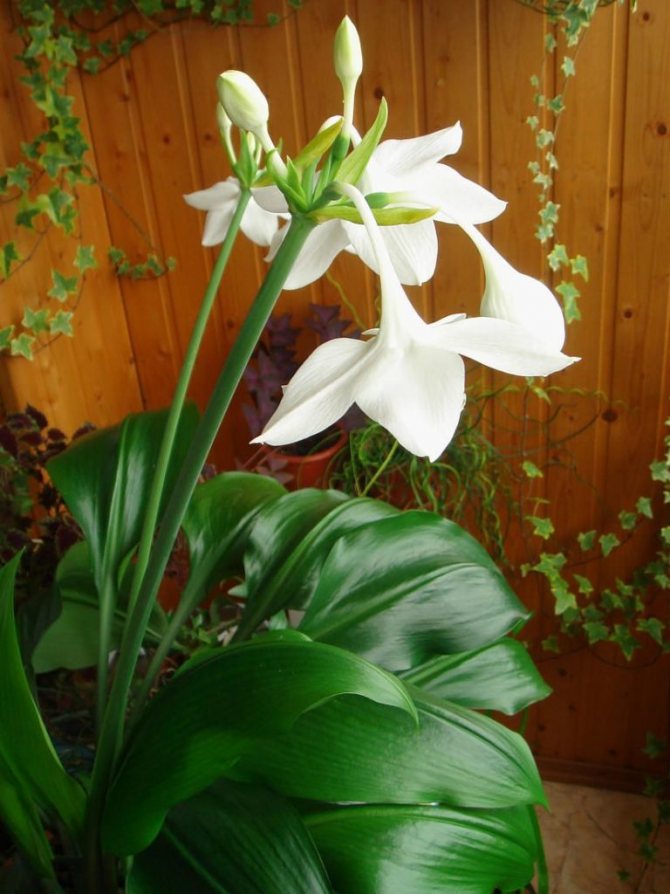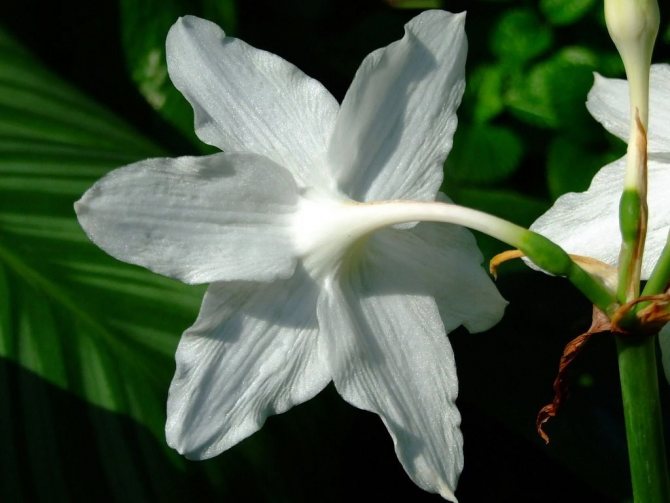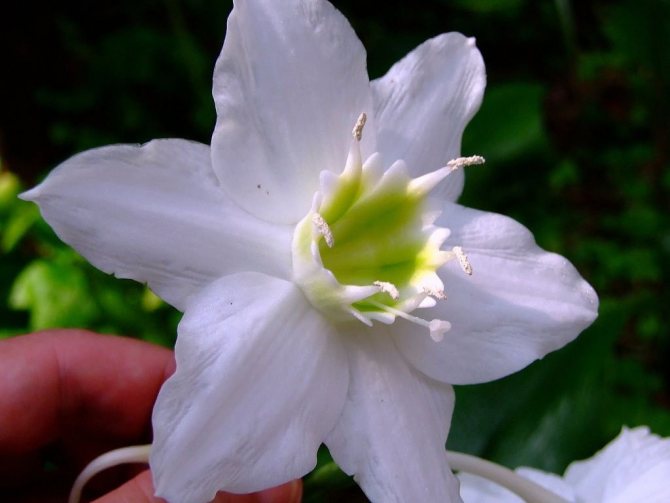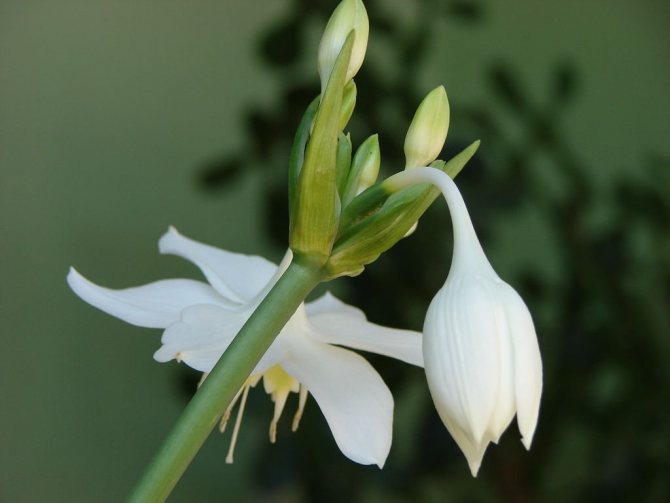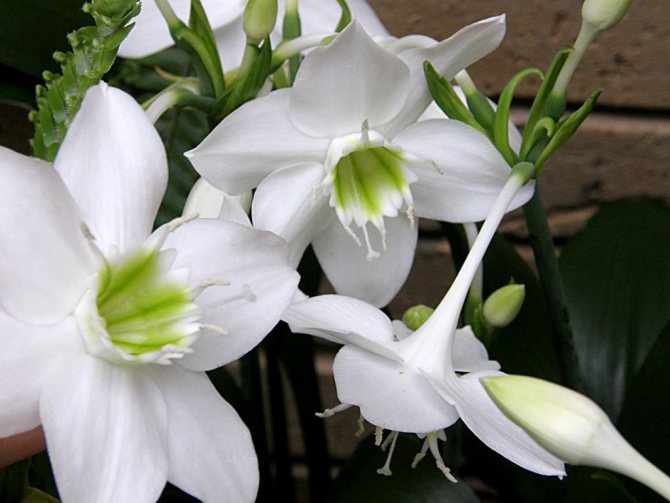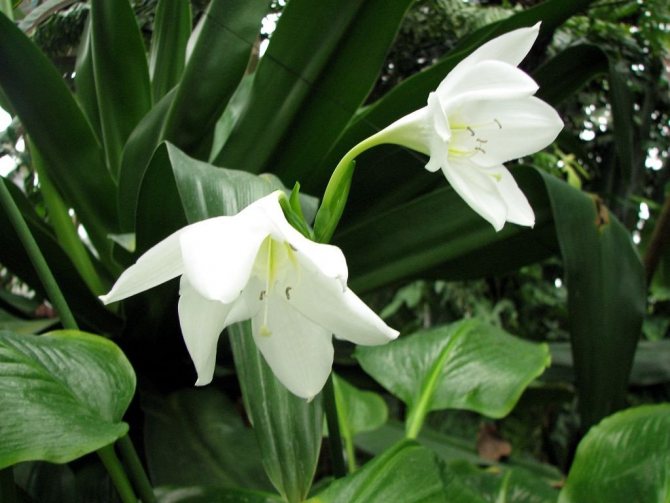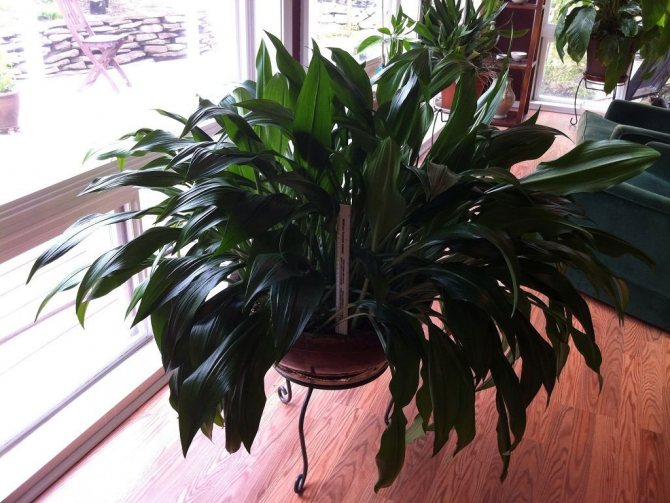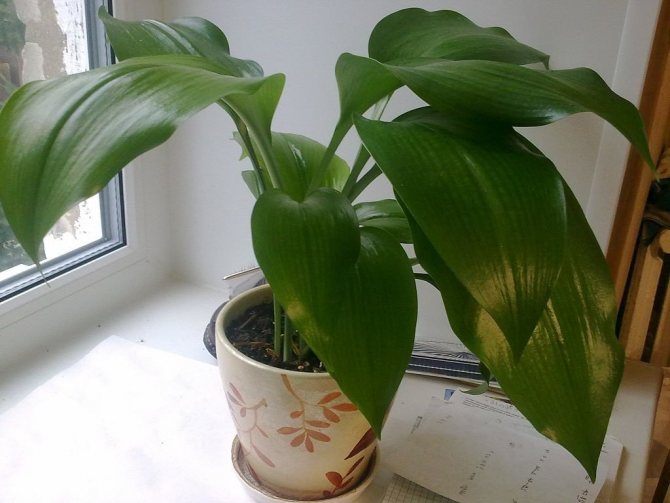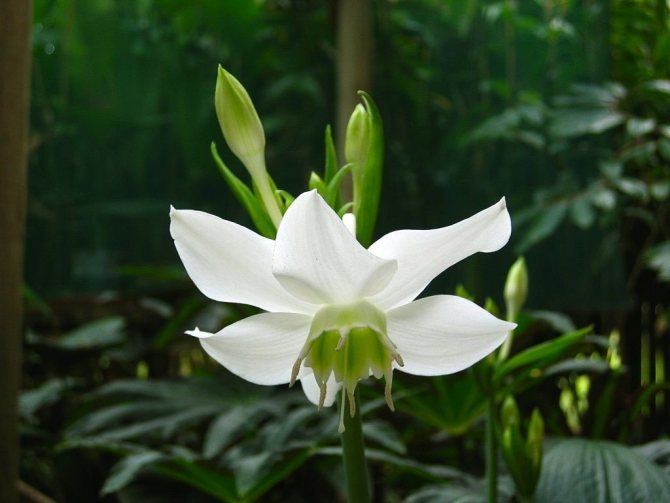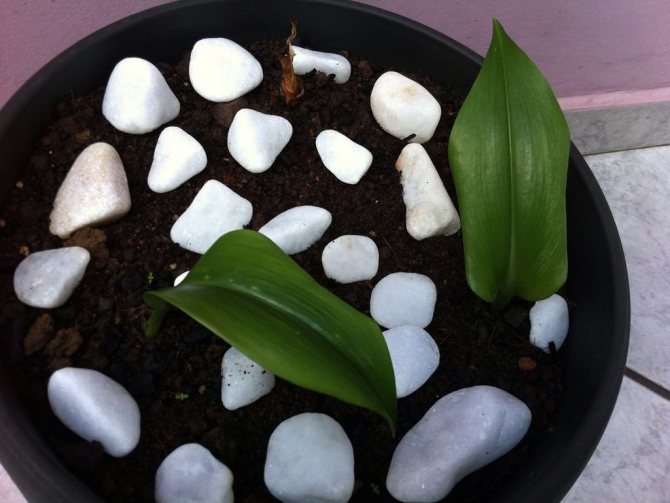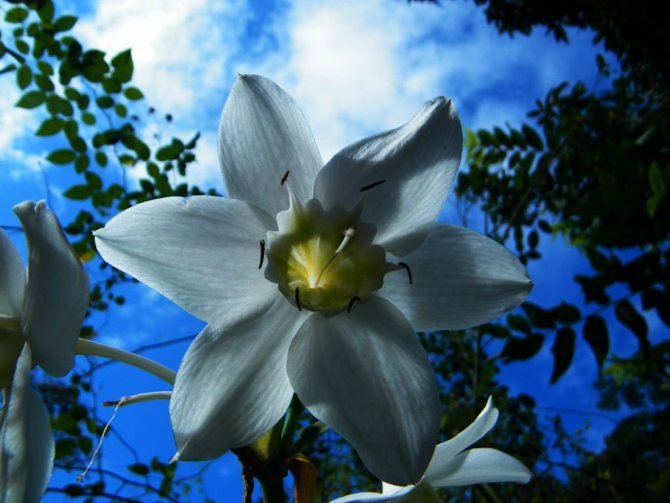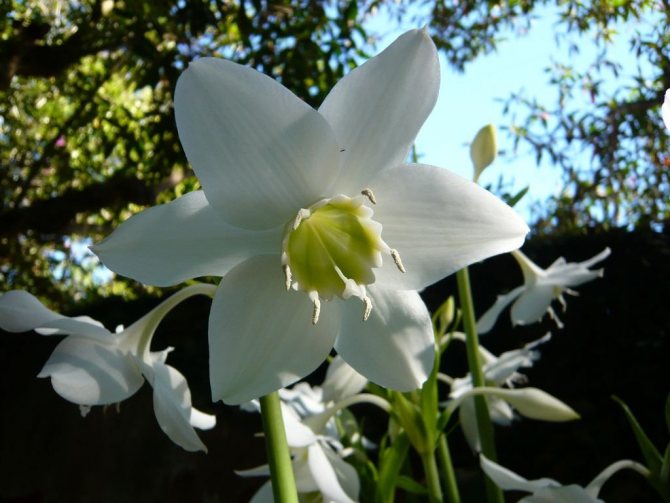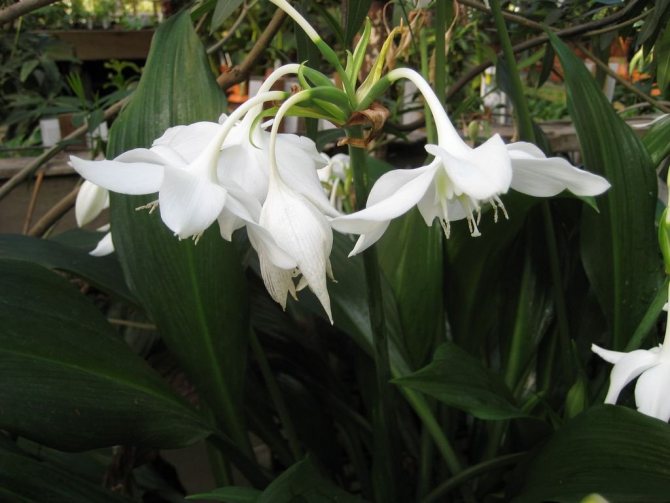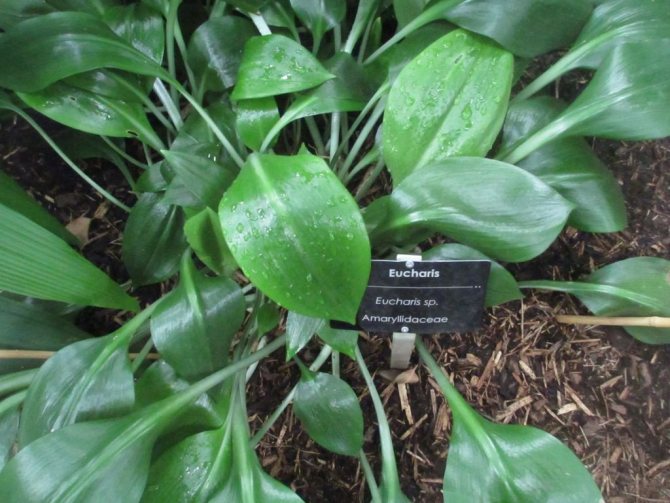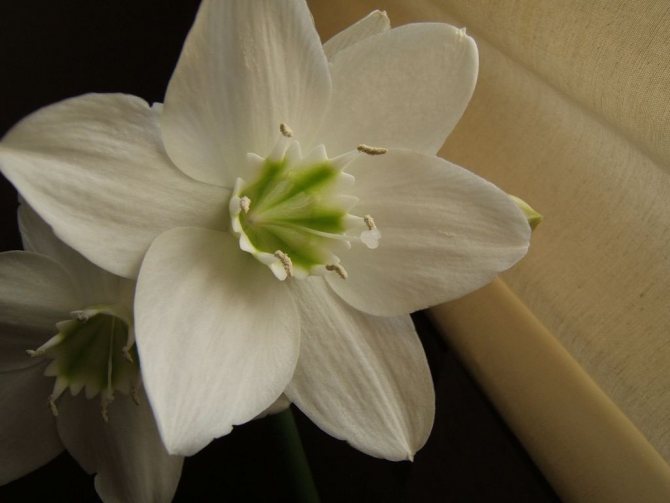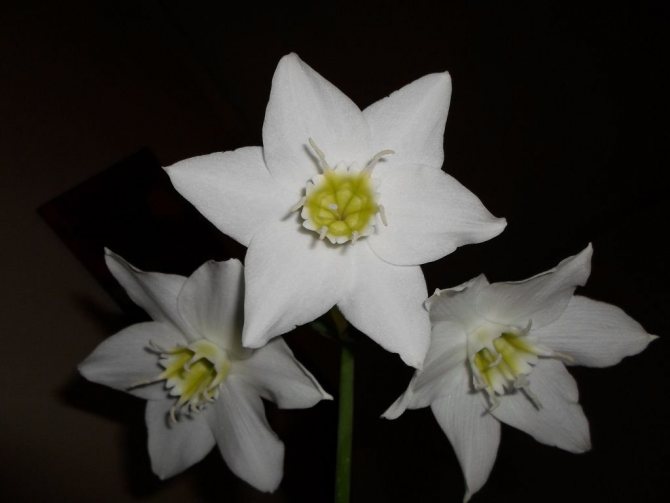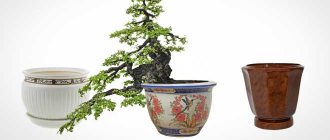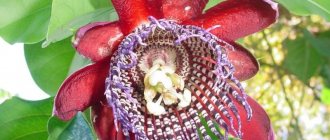Amazonian lily is also called eucharis, a perennial bulbous plant from the hot tropical belt of the planet. Its flowers are similar to large daffodils, sitting several pieces on a flower arrow.
Despite its beauty and southern origin, the plant is unpretentious and adapts well to home conditions.
Transplanting a plant into a new soil is necessary after purchasing eucharis. In flower shops, plants are in "transport" soil - a light peat substrate, poor in nutrients. The flower needs to be transplanted into another, fertile substrate.
Once every 3-4 years, eucharis is transplanted into a new soil and a pot of larger diameter. The baby, which has grown on the mother's bulb, does not need to be separated. This plant feels more comfortable when it grows in a heap.
How does the Amazon lily live at home?
The Amazonian lily is a type of bulbous plant. You can recognize this flower by its lanceolate leaves, large and fleshy. On thick long petioles, rosette out of a large bulb up to 6 cm in diameter. The length of the leaves of an adult healthy plant can reach 55 cm, width - about 20 cm. The color is emerald green, dark. Young leaves are light green in color and gradually darken.
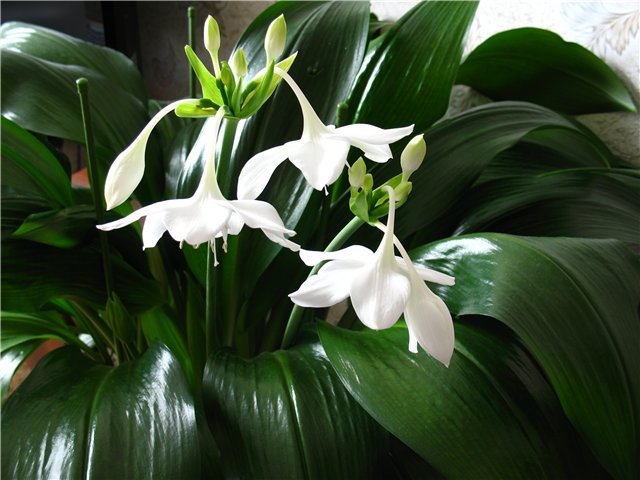
Eucharis will become a real decoration of your home
In August-September, eucharis begins to bloom. Its flowers on long peduncles are similar to daffodils: large, collected in inflorescences in the form of an umbrella, from 3 to 10 pieces. The color is white, the color of the crown is from green to yellow, depending on the type of plant. With good, proper care, eucharis can bloom not only in autumn, but also in spring, and sometimes even three times a year..
The Amazon lily came to Europe in the 19th century from the vastness of the Colombian Andes and Peru. Due to its beauty, the plant quickly won the love of flower growers who want to give their gardens a touch of rainforest. Eucharis turned out to be quite simple to care for and cultivate, and quickly took root in the conditions of home cultivation.
Diseases and pests
Eucharis is resistant to the attack of ticks and parasitic insects, the flower rarely gets sick. The reason for good immunity is the presence of the alkaloid licorin in the bulbs, stem and leaves. The substance not only protects a plant from the Amaryllidaceae family, but activates the production of vitamin C in the bulbs. The alkaloid is harmful not only to insects, but also to humans. It is no coincidence that many flowerpots with the Amazonian lily cannot be placed in a small area where there is no free access to fresh air.
How to deal with a scabbard? It is this parasite that can damage the Amazon lily.
To destroy the parasitic insect, insecticides are used:
- Actellik,
- Metaphos,
- Fitoverm.
The shell protects the body of the scale insect, and folk remedies are ineffective. First, all parasites are removed, then two or three treatments are carried out according to the instructions.
General information for a florist
Like any other flower grown at home, eucharis puts forward certain requirements for its habitat.
Table: optimal conditions for growing eucharis
| Parameters | Features and requirements |
| Lighting | Intense but diffused, shading may be required. |
| Temperature | Optimum in summer is 20-25 degrees, in winter from 17 degrees. |
| Air humidity | Medium, without exceeding the desired level and excessive dryness. |
| Watering | Moderate, without overdrying or waterlogging the substrate. |
| Transfer | No more than 1 time in 3 years, if necessary (if the bulbs are too tightly filled in the pot). |
| The soil | Nutrient mixture from different types of soil, compost, peat, organic fertilizers, sand; drainage is required. |
| Reproduction | Basically - dividing the bulb; less often - by seeds (the method is very time consuming and not always effective). |
Now let's take a closer look at each step of plant care.
External appearance
Eucharis is a perennial, evergreen plant. Its herbaceous growth 40-60 cm high forms sprawling thickets. The rhizome is represented by a large round or oblong bulb with a diameter of about 4-6 cm. Oval dark green foliage with a shiny surface grows in the form of a rosette from the ground itself. The leaves have long, erect petioles. In total, 2-7 leaves grow from one bulb, no more than 55 cm long, and up to 20 cm wide. On a slightly wrinkled surface, parallel relief veins are clearly visible.
Eucharis blooms most often in February-April. From the center of the bulb grows a fleshy tubular peduncle up to 80 cm long. Its top is decorated with an umbrella inflorescence, consisting of 3-10 buds. Flowers bloom in turn. Each has a long, narrow tube with oval, wide-open petals. Their edges are pointed. Six petals are arranged in 2 tiers. In the center there is a fused crown with staminate filaments growing to it. Each flower lives up to 10 days. Its petals are white, and the crown with stamens can take on a greenish or yellow tint.
After pollination, the fruits ripen - fleshy three-chambered seed pods with small elongated seeds. Under favorable conditions, flowering is repeated another 1-2 times during the year.
Care
The Amazon lily can live in your home for many years. The way to grow this plant successfully is to protect it from bright light and direct sunlight. The ideal location of the flower is the east or west side, where the midday sun will not touch its leaves. Intense but diffused light is what your green pet is sure to enjoy.
In the summertime, eucharis will feel great on the glassed-in veranda. But if it is too exposed to direct sunlight, the plant needs to be shaded with something. Consider this if you are going to take the flower out onto the balcony.
Air temperature
Eucharis is a rather thermophilic plant, it is not for nothing that hot tropical forests are its homeland.... But during different phases of the life cycle, this plant requires a different temperature regime. In any case, try to keep the temperature in the room where this flower stands, at least 15 degrees.
During the growth period of the Amazonian lily, more heat is needed, the optimum temperature is about 18 degrees. The same applies to the winter period.
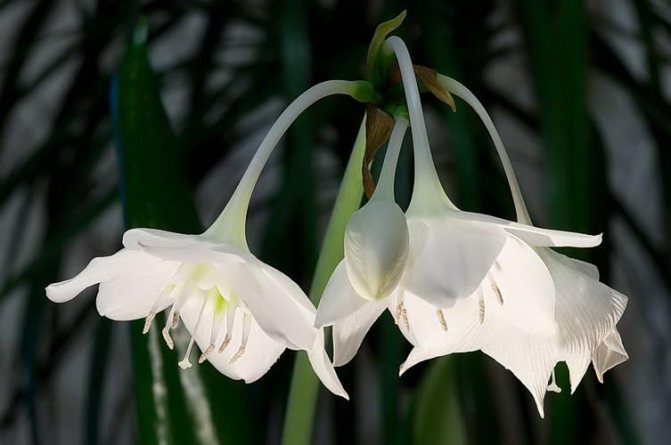

For good flowering, eucharis needs moderate, stable heat without temperature fluctuations.
Try to provide the plant with uniform warmth, do not allow sudden temperature changes with a large amplitude: this leads to crushing of flowers and disruptions in the flowering frequency.
Temperatures ranging from 7 to 10 degrees for eucharis are defined as damaging. Under such conditions, he begins to shed the leaves, and his bulbs freeze slightly.
Watering and spraying
Eucharis, like all plants of the amaryllis family with bulbous roots, is sensitive to soil moisture. Simply put, the leaves love water, and the roots of excess moisture are afraid. Therefore, control how moistened the soil in the flower pot is, and in every possible way avoid stagnant water, otherwise the root system will begin to rot.
Do not forget the most common rule: water abundantly, but infrequently. Better to wait until the soil is dry. If it is 3 cm deep, postpone watering for a couple of days..
The eucharis irrigation technique also has its own characteristics. Never pour water into the center of the flower, where the leaves are coming out of the bulb.... It will be correct to distribute the water evenly along the walls of the pot. So the soil is optimally saturated with moisture, and the bulb will be protected from waterlogging.
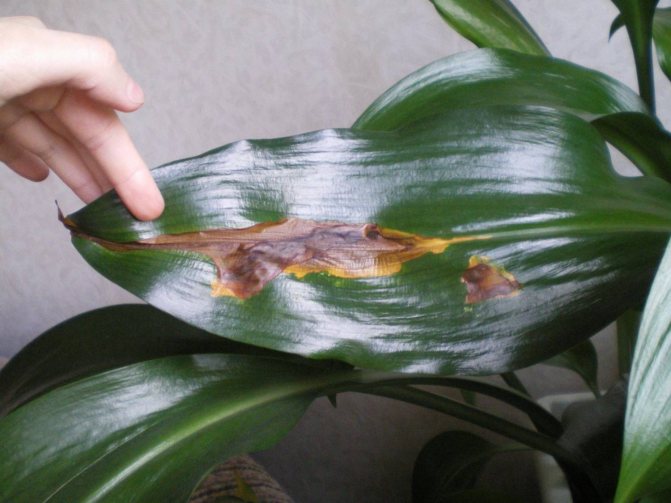

Avoid getting too much water on the leaves. to avoid burns
If you've just transplanted eucharis, water it gently in small portions. When new leaves begin to break through, increase the watering.
During the period of active growth, provide soil moisture 2-3 times a week. The soil or substrate in the flower pot should be kept in a moderately moist state at all times, but without stagnant water.
Reduce watering by 5-6 weeks to stimulate flowering. After the buds appear, watering must be resumed to its previous state.
The Amazonian lily has very large leaves on which house dust accumulates. As you know, a large amount of dust on plants impedes the access of air and sunlight. Therefore, the leaves should not only be regularly wiped with a damp sponge (only carefully so as not to break them), but also sprayed with water from a spray bottle. So you not only "cleanse" the flower, but also bring the conditions of its maintenance closer to natural ones: in its homeland, in the tropics, eucharis does not know a deficit in rain and humidity.
Top dressing
The need for feeding in eucharis arises only during the period of flowering and active growth.... As soon as the bud emerges from the bulb to the surface, feed the flower every 10 days with a solution of organic fertilizers - mullein, ash. With active growth, apply mineral and organic fertilizers alternately twice a month. You can get them ready-made from hardware stores. Special fertilizers are perfect for flowering or bulbous plants.
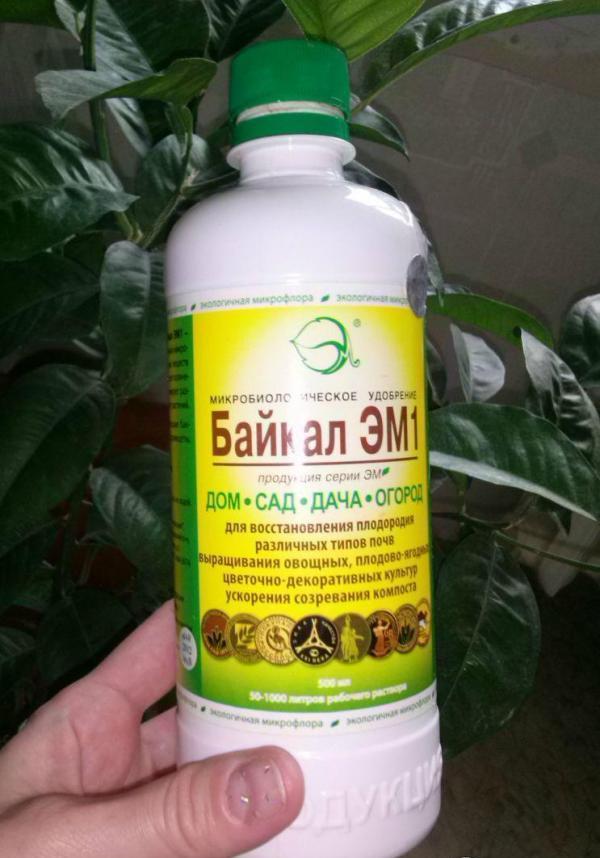

Eucharis loves organic and mineral fertilizers
After the eucharis has faded, feeding must be stopped.
Flowering time
During this period, in addition to feeding, the flower needs proper watering. It is very important to prevent waterlogging of the soil when the plant bulb gives so much energy to the flowers and the formation of boxes with seeds from them. Water the lily with water at room temperature as the soil dries... It is very important to provide holes in the bottom of the pot and mandatory drainage.
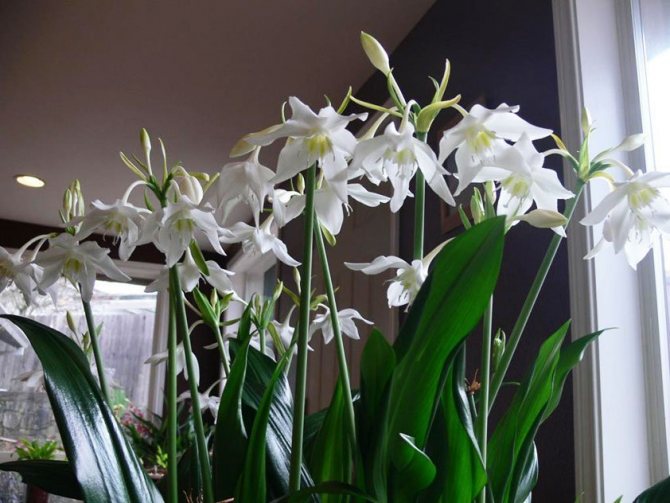

During the flowering period, eucharis needs special care.
Spray eucharis during flowering, but do not let water get on the flowers. In addition, moisture droplets should not concentrate on the leaves: this can cause burns. Wipe dust off the leaves constantly.
Do not move the flower pot to another location during flowering.
Dormant period
The dormant period begins immediately after the eucharis has faded, and lasts from 35 to 50 days. Peduncles are removed, plant feeding is stopped, watering is reduced to a minimum... This time is needed so that the lily does not immediately begin to expel new leaves, but has time to first throw off the old ones. And the root system will thus gain strength for a new flowering.
If you like, you can place the eucharis pot in a cooler room for a dormant period. But do not forget about the temperature regime of at least 15-18 degrees.
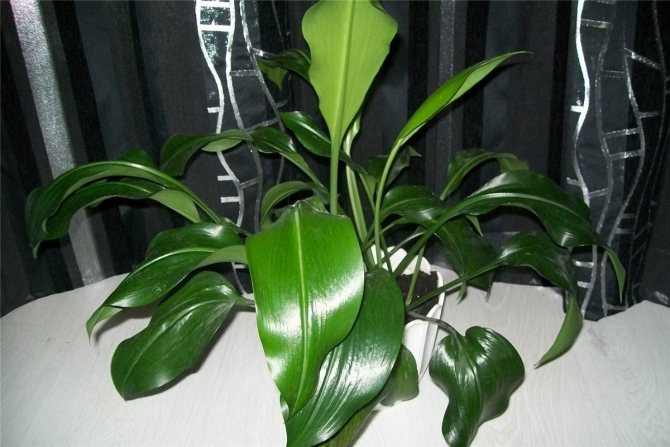

This is what eucharis looks like during a dormant period.
Such manipulations with watering and alternating temperature conditions during periods of growth and dormancy easily lead to the fact that eucharis blooms twice, or even three times a year.Usually, the most active bulb growth occurs in the middle of winter, and by March the plant forms a full-fledged flower arrow.
As soon as you notice new growth, resume watering and feeding.
Eucharis: features of care after flowering
After flowering, eucharis must provide a full dormant phase, which lasts about one and a half months. It is at this time that the plant gathers strength for future growth and flowering. Therefore, the intensity of its development in the next season directly depends on what kind of care will be provided to the Amazon lily at this time.
So, when the last flower is dry, the peduncles should be cut off (the leaves do not need to be cut off). The plant can then be moved to a less warm place and watering can be drastically reduced. Top dressing and spraying during this period should not be carried out at all.
In the resting phase, sometimes the leaves of the eucharis begin to turn yellow. You should not be afraid of this, the green mass will recover in speed.
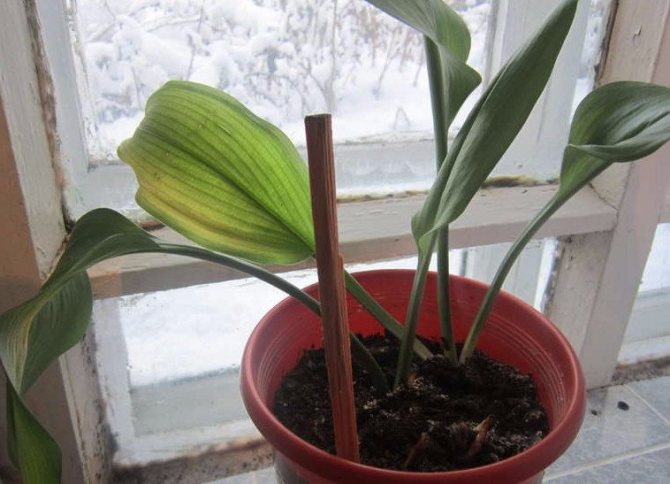

The end of the dormant period is evidenced by the appearance of young leaves from the soil. As soon as this has happened, you can start watering and fertilizing the eucharis again, and, if necessary, raise the temperature to a higher one.
Did you know? Sometimes flower growers manage to achieve eucharis flowering three times a year. In this case, the plant should also have three rest periods.
The dormant Eucharis looks just as attractive as during the growth period. It is not necessary to move the plant to a cool place, it is only important to reduce watering and stop feeding.
When and why to transplant
If you purchased an Amazon lily from a store, pay attention to the size of the pot. After purchase, the flower often needs a transplant. Eucharis needs space for growth, therefore, if the bulb is large and the capacity is small, it is better to immediately transplant it. In this case, certain rules must be taken into account.
The best time to transplant eucharis is early spring, namely March... The flower needs replanting once every 2-3 years. This should be done after the end of flowering, when the plant goes into a dormant period.
Take your time to repot the Amazon lily, even if it has already filled the pot. Only do this when the bulbs become too crowded. The new container should be only a couple of centimeters wider than the previous one..
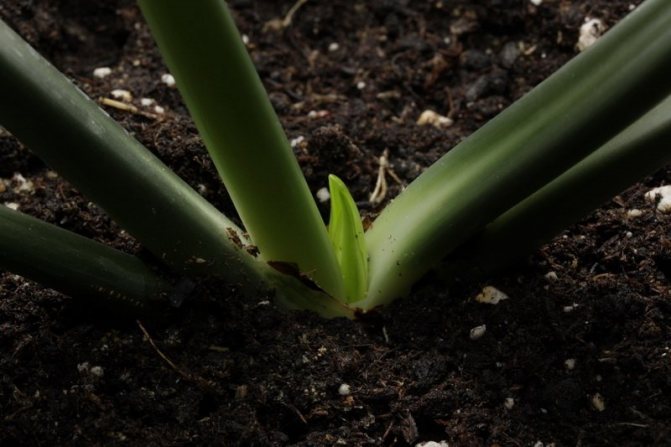

Eucharis after transplant with a young sprout
Choose wide ceramic pots or wooden boxes for planting. The container should be quite massive: eucharis grows to a large size and can overturn light small dishes.
Soil preparation
Eucharis needs a substrate with good moisture holding capacity. You can prepare a suitable soil yourself from several components:
- 2 pieces of leafy land;
- 1 part of sod land;
- 1 part of peat land;
- ½ part coarse sand.
The following mixture also works well for these colors:
- 4 pieces of leafy land;
- 2 parts compost;
- 2 parts of sand, perlite or vermiculite;
- 1 part loam.
Compost can be replaced with bone meal or rotted cow dung. And to avoid putrefactive processes over time, pour some charcoal into the soil.
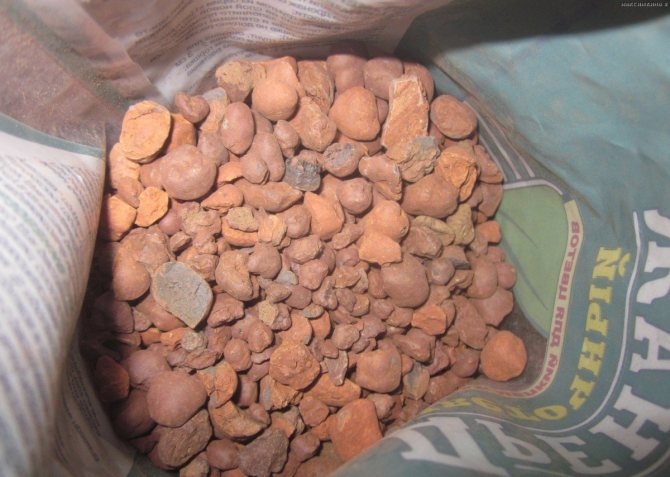

Ensure good drainage before planting eucharis
Be sure to provide a thick layer of drainage by placing fine rubble, expanded clay, shards or pebbles on the bottom of the pot.
How to transplant correctly
Eucharis is very afraid of damage to the bulb, roots and leaves. Keep this in mind when transplanting, if you do not need to plant eucharis, then try not to violate the integrity of the earthen coma.
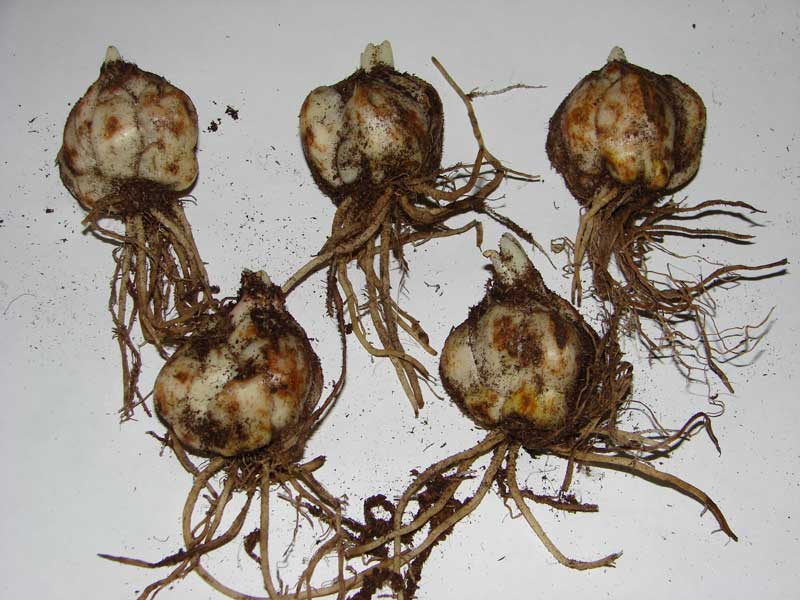

Reproduction of lilies from bulbs is the fastest way
Gently loosen the earthen ball with a stick, straighten the roots. Gently rinse the tangled parts of the roots in running water at room temperature.
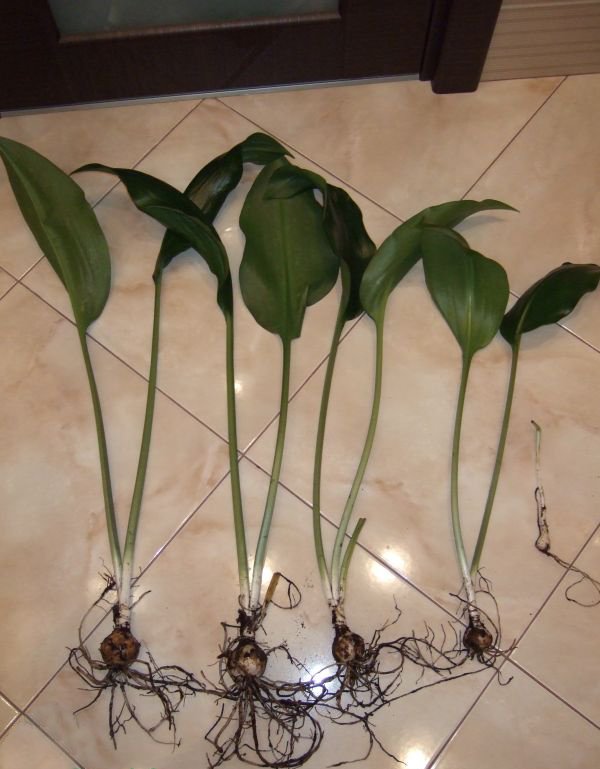

Separate the bulbs carefully before replanting without damaging the root system.
Prepare the pot, lay the drainage on the bottom, pour the substrate up to half the container. Place the bulbs (3-5 in each pot), straighten the roots, add the substrate and tamp it well.
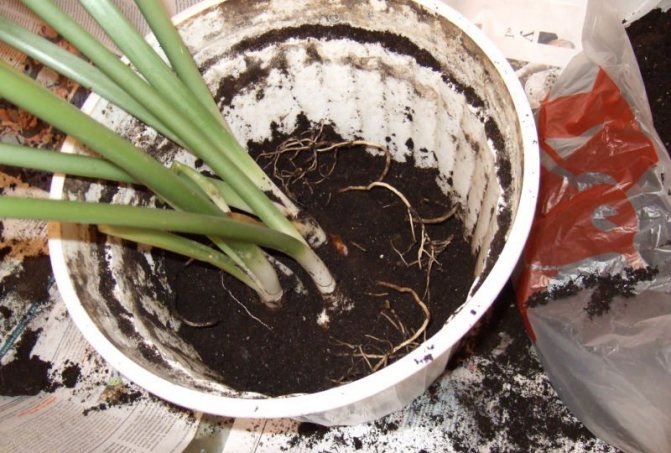

Deepen the bulbs a few centimeters into the soil
Young bulbs are planted 2-3 cm below ground level. If there are no leaves on them, leave the tops above the soil so that it is easier to observe the beginning of growth. Immerse adult bulbs with leaves 4–5 cm in the ground.
Water the eucharis immediately after transplanting. For the next 3 weeks, water it moderately as the soil dries up. That being said, try to spray the flower abundantly and regularly, especially if it has leaves. Within a month, new leaves will begin to appear on the plant.
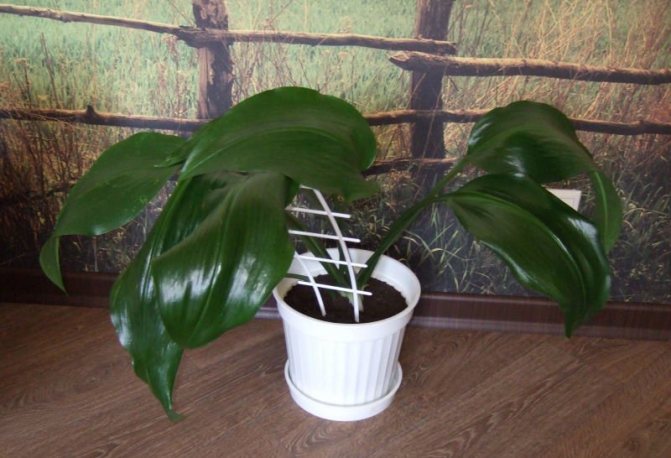

After transplanting, eucharis needs moderate watering as needed.
When to do eucharis transplant
The flower is transplanted only during the dormant period, after flowering. Blooming eucharis may not survive root trauma.
The best time to move a flower to a new pot is early spring. At other times, it is necessary to transplant the flower very carefully, using the "transshipment method" without destroying the earthen coma.
Autumn transplantation is carried out only if absolutely necessary, if the eucharis is sick and needs to change the substrate. To facilitate the process of changing the soil, the plant is watered with Kornevin, and the leaves are sprayed with Epin.
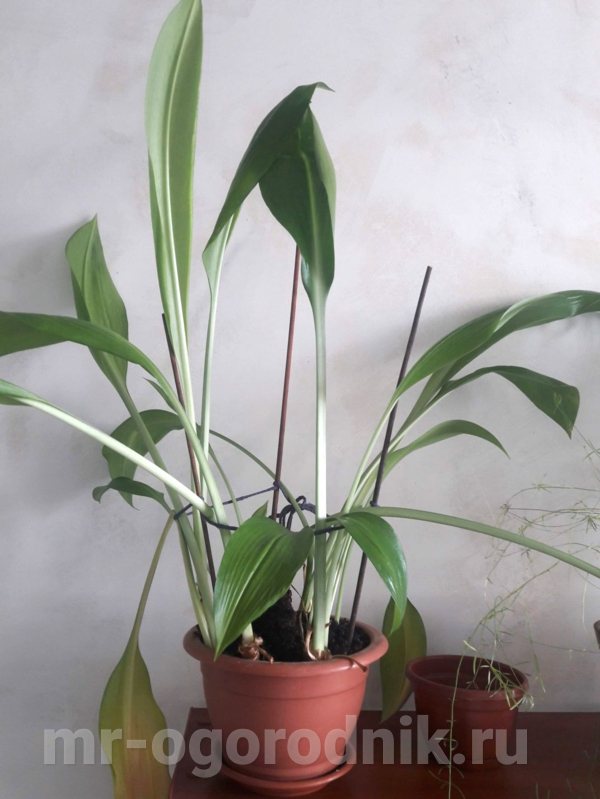

Eucharis does not bloom and other problems
Flowers, like all living things, need certain conditions for a full life, and drastic changes often lead them to illnesses. Unlike humans, a plant cannot explain the causes of damage. Therefore, take a close look at your eucharis: its appearance can tell a lot.
Care errors
The most common problems arise from improper flower care.
- Yellowing and dying off of the lower old leaves of the eucharis. During the period of active growth of new leaves, the old ones turn yellow and die off, this is natural. But if the process takes on a massive nature, the reason may be waterlogging of the soil. Remove the bulbs from the pot and inspect carefully. If they are damp and soft to the touch, and their color is uneven, it's bad: the process of decay has begun. But you can still save the flower. Remove the damaged areas with a knife, sprinkle the sections with chopped activated carbon, dry in the fresh air and place them back in the soil.
- Loss of density and uniform smooth shape by leaves. Usually this is how the plant behaves when there is a lack of moisture. But if after watering the leaves do not take their original shape, remain sluggish, then hypothermia may also be the reason. Do not allow the temperature to drop below the optimal mark, do not water the eucharis with cold water, check that the soil warms up well.
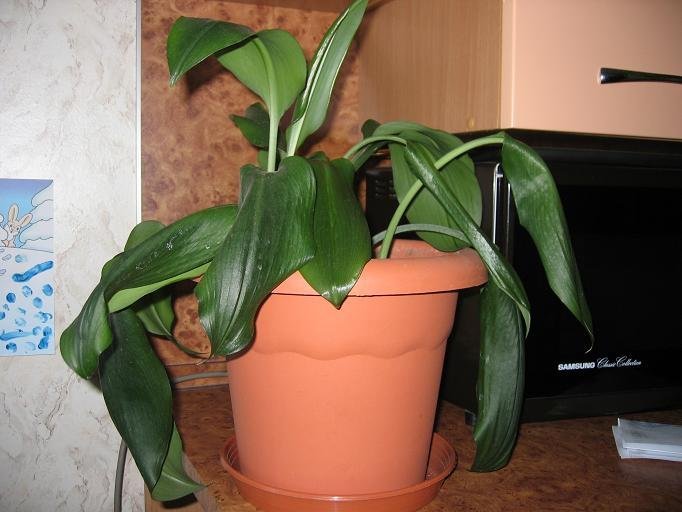

Loss of elasticity and density by leaves is a sign of lack of moisture or hypothermia
- Eucharis does not bloom... Many novice florists make a big mistake, often replanting euharius, hoping that this will correct the situation. In fact, the plant needs to form daughter bulbs, which will serve as a prerequisite for flowering. Therefore, provide the lily with a dormant period in good lighting conditions and stimulate it with fertilizers such as "Bud", "Blossom", introducing them in small quantities into the moist soil.
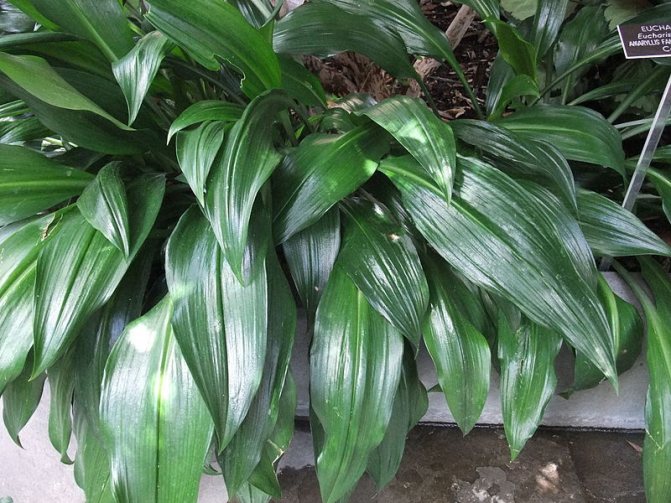

If eucharis does not bloom for a long time for no apparent reason, try to stimulate it with special fertilizers.
- Leaf deformation... Do not be alarmed: the plant rolls up the leaves so that they do not evaporate moisture. This is usually due to the dry air around the flower. Wipe the leaves often with a damp sponge to remove dust and provide access to water. Young leaves turn out to be deformed only if they received mechanical damage during unfolding.If all the leaves lose their shape, the cause may be insect pests (you can see them on the inside of the leaf), hypothermia of the soil and root system, or excess fertilizer.
- Falling leaves... If, with the appearance of new leaves, the old ones immediately begin to fall off, be aware: the plant signals you about the lack of resources for life support. Most often this happens in winter, in conditions of a lack of sunlight. Provide additional artificial lighting for the flower, water it regularly, avoiding drying out or waterlogging of the earthy coma. Try fertilizing eucharis.
Insect pests and diseases
Eucharis is distinguished by enviable resistance and excellent immunity, but it can still be susceptible to diseases or harmful insects. And the reason for this is simple: improper care or lack of it at all. Beautiful lilies can harm:
- spider mites;
- scabbards;
- thrips.
If they have already taken up positions on the plant, then you can easily notice their waste products in the form of clusters of cobwebs. Systemic insecticides, for example, Fitoverm and Actellik, will help you get rid of the misfortune. You can buy them at any flower shop.
Use chemicals strictly according to the instructions!
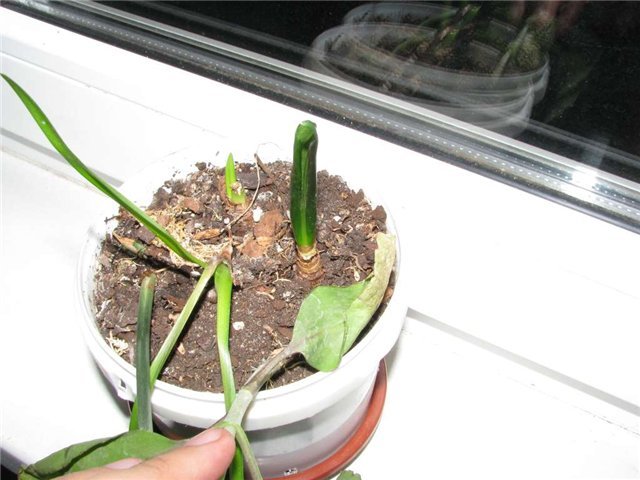

In case of lesions and diseases and pests, the flower cannot be left without treatment, this can lead to its death
The most common disease among bulbous plants, including eucharis, is gray rot. It can develop in conditions of high air humidity, low temperatures and waterlogged soil. Have you noticed signs of the disease? Apply measures: moderate watering, treat the flower with Bordeaux liquid. Such products as "Topaz" and "Champion" have proven themselves well in the fight against the first signs of gray rot. If the lesions become too extensive, remove the diseased areas to healthy tissue, and treat with copper sulfate or other copper-containing contact preparations.
Reproduction of Eucharis:
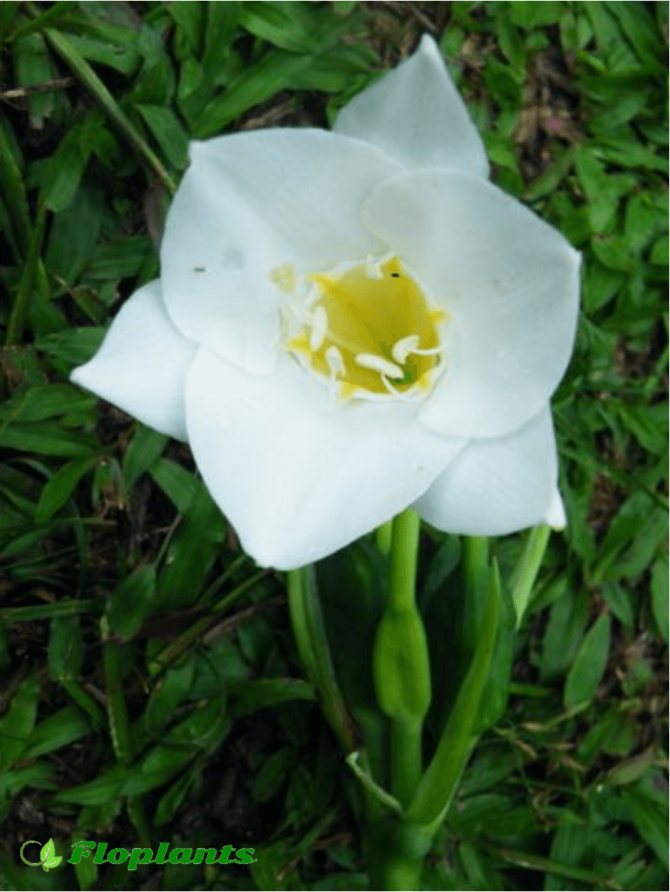

The plant propagates by daughter bulbs, dividing bulbs and seeds.
Most often, Cyntanthus is propagated by daughter bulbs, which are separated with the complete preservation of the earthen coma and with the complete preservation of all the roots of the mother plant. This gentle separation allows a shallow planting of the mother bulb. Onions with a size of 3 cm and more and having small roots are subject to separation. The onions are planted in separate pots and during the first few years they do not organize a dormant period and are actively watered, fertilized, it is possible with a bias towards nitrogen. Thanks to this content, the bulbs can bloom for 2 years.
For reproduction by division, bulbs with a size of at least 6 cm are taken. If necessary, part of the soil substrate is removed so that only the roots of the plant are in the ground and the entire bulb is cleared of scales. The upper part of the bulb is cut off along the border of the foliage, capturing a little of the bulb's surface. Then the bulb is cut into 4 vertical equal parts, the cuts should reach the surface of the substrate. Between the slices, you need to insert metal or wooden knitting needles 5-6 mm in size. The optimum temperature for breeding is 22-25 ºC. For a divided bulb, care should be the same as for a normal plant. When the first daughter bulbs appear, it is necessary to carry out the first application of fertilizers, after that, fertilizers are applied at the same frequency as for an ordinary plant. In the spring, plant the resulting group of bulbs in separate pots. This is usually 5 to 7 onions.
It should be borne in mind that during seed propagation, the varietal qualities of the bulbs are not preserved, but plant specimens obtained in this way age and grow faster. With seed reproduction, it is necessary to pollinate the flower.With the help of a brush, pollen from the stamens of one plant is transferred to the stigmas of another. If the procedure is successful, a fetus is formed that ripens from 4 to 6 weeks. The crackling of the capsules serves as a signal that the seeds are ripe. Seeds lose their germination within 5 weeks, so planting is carried out immediately after collection. It should be borne in mind that fresh seeds have 100%, but if the seeds are dried, the germination rate will drop to 30%. Seeds are poured onto the surface of the substrate and covered with 5 mm soil. The pot is kept at a temperature of 22-25 ºC keeping the soil constantly moist. When the seedlings form 2-3 leaves, they are planted in separate containers. For the first 2 years, young bulbs are kept constantly with leaves.
Signs and superstitions
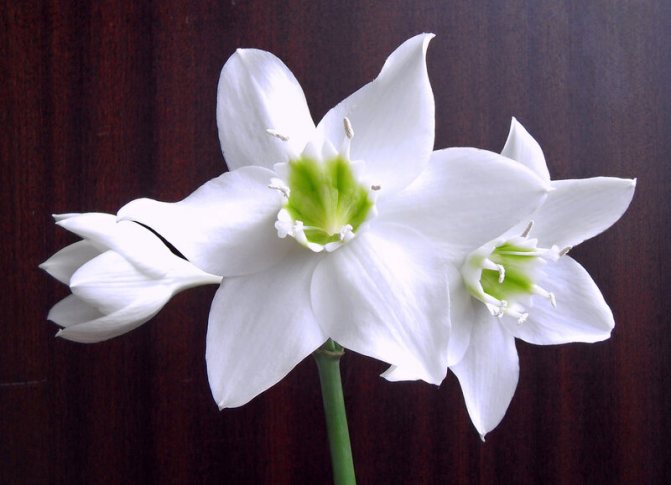

- It is believed that eucharis or Amazonian lily protects women from the evil eye, damage and other troubles. In his homeland, in the upper reaches of the Amazon, the bride's hair is adorned with the flowers of this plant - this guarantees a happy family life for the newlyweds. If you insert a sprig of eucharis into a wedding bouquet, it will only enhance the effect of the amulet.
- The appearance of a peduncle with three flowers in the house predicts an imminent pregnancy. The third bud symbolizes just the appearance of the baby.
- If the flower suddenly dried up, then damage was put on one of the family members. The plant feels this, takes all the negative on itself and dies.
- If the Amazon Lily refuses to bloom, this is cause for thought. Perhaps the family is tense. Its powerful energy will help to establish marital relationships and eliminate conflicts between relatives and friends.
- The flower is recommended to be grown in a family where children grow up. It is believed that it contributes to the development of mental abilities of babies, absorbs their fears, reveals talents. But do not forget that eucharis is poisonous. Children should not touch it with their hands.
Planting several Eucharis bulbs in one pot
As you know, a single Amazon lily bulb will not form a flower arrow until a sufficient number of children grow on it - this is a genetic feature of the plant.
Interesting! It is permissible to get a decorative specimen of Eucharis and accelerate the beginning of blooming of its flowers by planting several bulbs in a flowerpot.
In this procedure, a wide and stable vessel is used in which several bulbs could be placed, leaving above the soil surface of their tops. Number of planted bulbs depends on the volume of the pot.
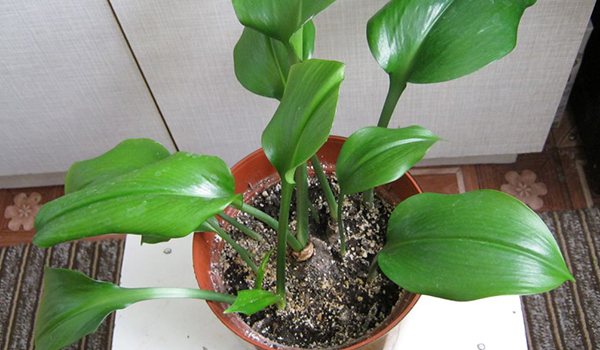

Eucharis species with a photo: Amazonian, Masterza, Sandera and toothless
The most common types in room culture are:
Eucharis amazonian (Eucharis amazonica). Plant with beautiful broadly elliptical, shiny, dark green leaves on long petioles. Outwardly, the leaves of the plant are very similar to the leaves of the well-known aspidistra, but they are softer, softer to the touch. Bulb of the Amazonian eucharis up to 5 cm in diameter. With careful indoor care, the plant can bloom twice a year. The flowers are rather large, up to 10-12 cm in diameter, snow-white, fragrant, collected in 3-6 inflorescences, the so-called capitate raceme, or a simple umbrella. Peduncle 60–70 cm long. This beautiful plant grows in forests near the headwaters of the Amazon River and in the foothills of Colombia.
Eucharis Masterza (Eu. Mastersii Baker) has an ovoid bulb, the diameter of which reaches 5 centimeters. Wide-oval green leaves are rounded at the base. They are 25 centimeters long and 14 centimeters wide.
Pay attention to the photo - in this species of eucharis, almost sessile, umbrella-shaped flowers are located in a rounded peduncle:
The flower petals are oval, reaching three centimeters in length. Flowering occurs in early March. Homeland - humid tropical mountain forests of the Colombian Andes.
Eucharis Sandera (Eu. Sanderi Baker) has an ovoid bulb. The leaves of this plant are broadly oval, heart-shaped at the base, with a petiole, the length of which is 10-15 centimeters.The rounded peduncle contains 2-3 sedentary white flowers in an umbrella. Flowering occurs in February and March. Homeland - rainforests of Colombia. Eucharis Sandera is widely known both in culture and industry.
Eucharis toothless (Eu. Subedentata Benth) has an ovoid bulb. The leaves of the plant are triangular-oblong, their length is 15–23 centimeters, and their width is 8–11 centimeters. The narrow peduncle contains 6-8 flowers in an umbrella. Eucharis' white flowers bloom on stalks. Homeland - the mountains of the Colombian Andes.
Beneficial features
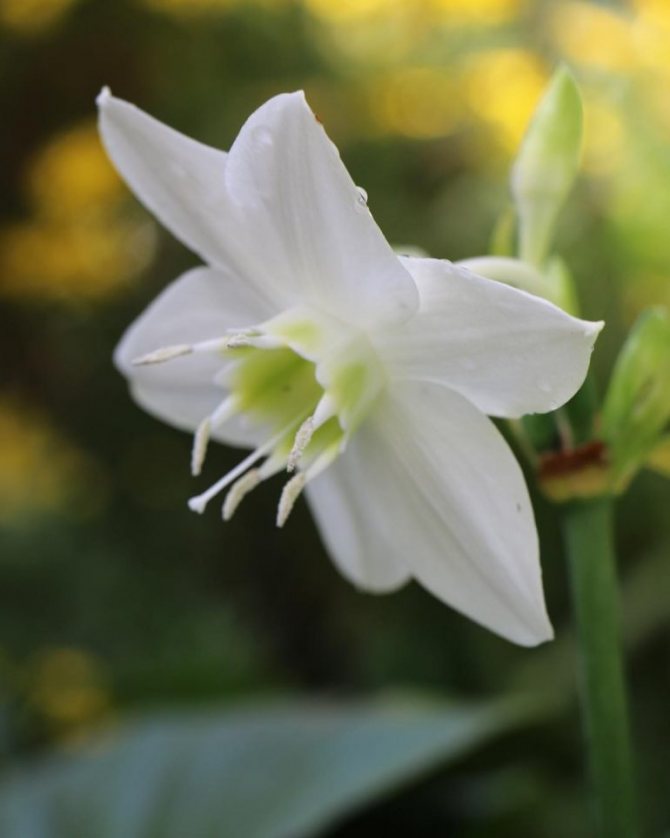

Blooming Eucharis. Photo
The flower is insidious. The plant's toxicity is hidden behind its spectacular appearance. All parts contain a poisonous substance - lycorin, even a small dose of which can cause severe vomiting and dizziness.
Pharmacologists extract this alkaloid from plants and use it to produce bronchodilators that thin and remove phlegm. Licorin also relieves pain and inflammation, eliminates fever, and even inhibits the growth of cancer cells. According to legend, the flower gives the spouses peace and harmony.
Botanical description of the plant
The genus Eucharis (Eucharis) has about 20 species of plants of the Amaryllidaceae family, flowering in winter and differing only in minor botanical features. The word "eucharis" in translation from Greek into Russian means "graceful". This name is quite justified - the plant stands out among indoor flowers for the beauty of leaves and flowers, a strong aroma.
The leaves are large (up to 40 cm long and 20 cm wide), broadly oval, pointed, dark green, shiny. In shape, they are similar to the aspidistra ("friendly family"). The leaf blade is slightly wrinkled, with protruding longitudinal veins. Leaves live for a long time, for several years; but after the autumn flowering they partially die off. Then, to replace them, new, young ones grow, initially rolled into a tube.
In skilled florists, eucharis blooms twice a year. In well-developed specimens, 5-8 peduncles (sometimes more) appear in October-November, at the beginning of summer - 2-3 pcs. Some plants bloom on New Year's Eve too. The flowers are large, up to 10 cm in diameter, similar to a daffodil, snow-white, slightly drooping, collected in a simple umbrella on long leafless stems (up to 70 cm). In the center of the flower, a dense, greenish crown with teeth along the edge stands out.
Pot
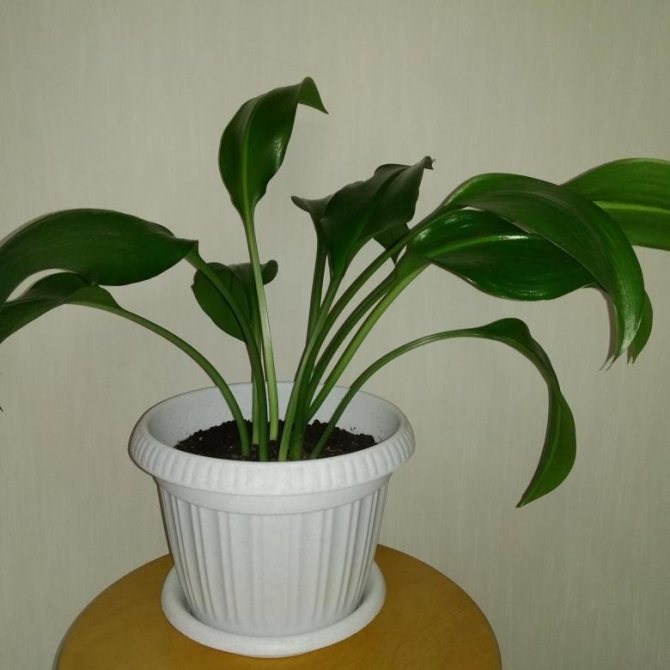

A pot for eucharis needs such a width and height that several onions grow nearby, so that their roots quickly braid the entire earthen ball and the plant blooms. The container must be stable. A pot that is too narrow and tall will collapse under the weight of lush leaves. Typically, a Eucharis pot is 15 cm in width and height. In a 2-3 liter pot, 5 onions can be placed at once. It will take two to three years before you need a pot that is slightly larger in diameter. For large group plantings, you will need stable floor flowerpots, the depth of which is from 30 cm or more.
Do not forget about the drainage holes and the drainage itself. Most often, purchased coarse expanded clay is used as drainage (small expanded clay will pour out from the large drainage holes of the pot). Although clay shards, small pebbles, and polystyrene are also suitable.
Content
- Listen to the article
- Description
- Caring for eucharis at home How to care
- Fertilizer
- Eucharis transplant
- Reproduction of eucharis
- Eucharis after flowering
- Pests and diseases
- Eucharis large-flowered
Possible difficulties
Bulbous plants are prone to fungal diseases, especially with dampness and excessive moisture in the soil. Eucharis periodically suffers from gray rot and spotting. In this case, it is necessary to cut off all the affected areas and carry out the treatment with a fungicide (Champion, Topaz, copper sulfate).
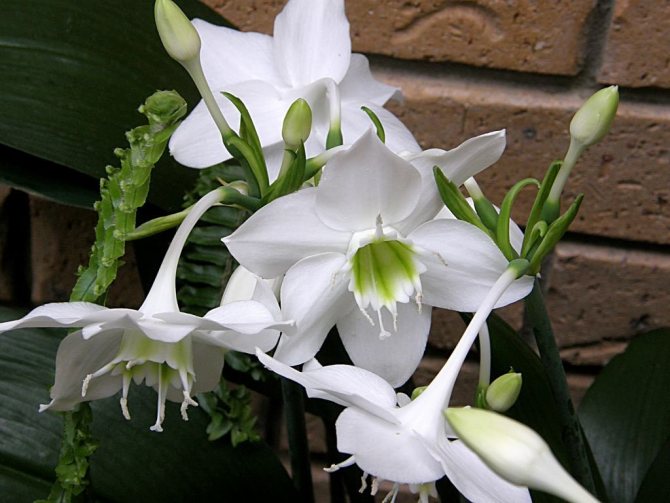

Of the parasites, the plant is bothered by thrips, scale insects and spider mites. Most often they settle on a weakened eucharis. At the first signs of insects, they are treated with an insecticide (Fitoverm, Aktellik).
If you had to face such a problem as yellowing leaves in eucharis, this indicates a plant disease. This happens with a sharp change in conditions of detention. The bulb suffers and the nutrition of the flower is disturbed. Possible reasons include too dry soil or a sharp increase in watering, exposure to drafts or a rapid change in temperature. Providing the plant with favorable conditions and protecting it from any changes, you can return to its former appearance.
If the eucharis does not bloom, it is important to create the correct rest period for it. To do this, the flower is rearranged in a cool, darker room, watering is reduced and fertilization is stopped. After 4-5 weeks, the flower is returned to its usual conditions. This shaking often leads to the formation of a large number of colors.

